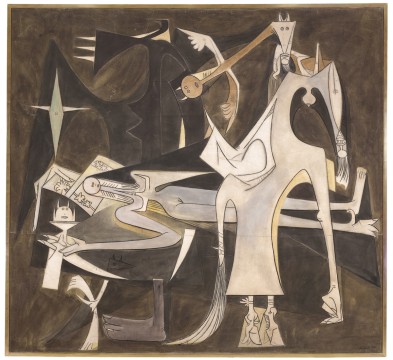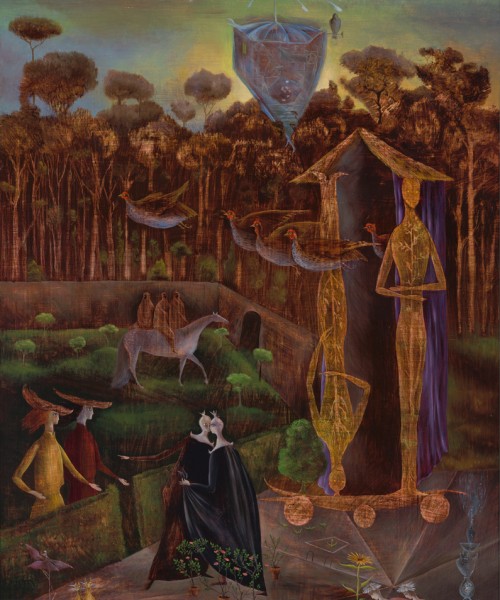





Donors, friends and guests with a privilege pass may book a single or multiple time slots here
Donors, friends and guests with a privilege pass may book a single or multiple time slots here
Would you also like to experience more Boijmans or give a friendship as a gift? Join as a Friend and get invited for the annual Museumpark Vriendendag. Will we see you or your friend in the depot soon?

With the opening of the exhibition ‘Only the Marvelous is Beautiful. Surrealism in Dialogue between Museum Boijmans Van Beuningen and Museo del Palacio de Bellas Artes’ in Mexico City last weekend, the surrealists from Rotterdam have reached the third stop-over in their world tour.
All the works that were previously exhibited in Wellington and Seoul are now on show in Palacio del Museo de Bellas Artes, including Dalí’s ‘Mae West lip sofa’, ‘Le Tabernacle’ by Yves Tanguy and ‘The Living and the Dead’ by Phillip West. Leonora Carrington’s ‘Again the Gemini Are in the Orchard’ has also temporarily returned to the country where the painting originated. In the exhibition, the Boijmans collection enters into a dialogue with Mexican surrealists. A remarkable number of female artists have played a crucial role in finding new ways of illustrating their vision on the world. In addition to Carrington, these included Remedios Varo, Alice Rahon, Kati Horna, Lola Alvarez- Bravo, Maria Izquierdo and Bridget Tichenor. ‘Only the Marvelous is Beautiful’ can be seen in Mexico City until 2 October 2022.

Museum Boijmans Van Beuningen has primarily collected European masterpieces from the first stage of surrealism. Many of these works of art are from the collection of Edward James, while others have been acquired over the years. The dialogue with the Mexican surrealists has given a fresh twist to the travelling exhibition. The number of works on show has been supplemented with more than 40 works from local museum and private collections. The works are intertwined with the existing themes and the Mexican connection has also given rise to new themes. There is, for example, an historic reconstruction of the international surrealist exhibition in Mexico City in 1940 and a room dedicated to Edward James and his surrealist garden ‘Las Pozas’ in Xilitla. Several pre-Columbian objects have also been added; these are comparable to the objects collected by André Breton and other European surrealists.
In 1938, the leader of the French surrealists André Breton visited Mexico together with his wife, the artist Jacqueline Lamba. They were received by the artist couple Diego Rivera and Frida Kahlo, and travelled around for several months. During this stay, they met numerous Mexican artists and intellectuals. Breton, Rivera and the dissident communist Leon Trotsky collaborated on a Manifest for Independent Revolutionary Art, in which they challenged the emerging fascism. It quickly transpired that fascism was more than a threat. War broke out in Europe and Mexico became the new home for many surrealist artists, including Leonora Carrington, Wolfgang Paalen, Alice Rahon and Remedios Varo.
In Mexico, the female artists were given the opportunity of freeing themselves from their role as muse and to develop their own voice. The new homeland nourished their interest in archaeology, anthropology, mythology and various forms of occultism. Their work shows a world view in which feminism, ecology and magic fuse together and add a new dimension to the surrealist universe. They also testify to the crucial role played by Mexico during the second period of surrealism.



Surrealism was not a style or a movement with a prescribed visual language, but rather a new way of looking at the world. The surrealist world view arose in the twenties of the previous century as a reaction to the western norms and values which had emerged from the enlightenment. Surrealists questioned the idea of eternal progress, rational thinking, scientific empiricism and individualism. They emphasised instead the value of the sub-conscious, the dream, eroticism and imagination. In their search for alternative ways of understanding reality, they delved into the beliefs, rituals and knowledge of old civilisations. For these artists, Europe was far from the centre of the world. The Pacific Ocean, the north-west coast of America and Mexico embodied the surrealist spirit.
During the large-scale renovation and renewal of the museum, one of the spearheads is to keep the collection visible at home and abroad. The traveling exhibition program ensures that people on different continents can get acquainted with the art collection of the city of Rotterdam.
The exhibition ‘Only the Marvelous is Beautiful. Surrealism in Dialogue between Museum Boijmans Van Beuningen and Museo del Palacio de Bellas Artes’ is a collaboration with Museo del Palacio de Bellas Artes in Mexico-stad. Curator Teresa (Tere) Arcq, known for her research into and publications on female surrealists, has been recruited especially for this. This special exhibition concept was created together with the curator of education Els Hoek van Boijmans.